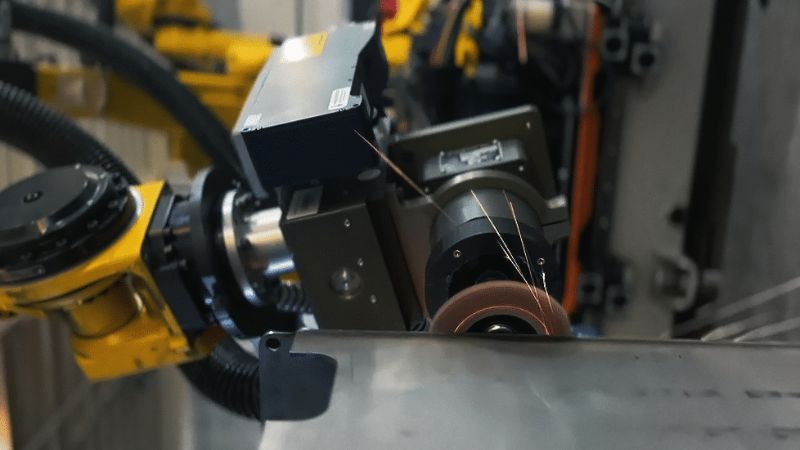GrayMatter Robotics Receives $45 Million to Advance AI-Driven Robotics Automation
GrayMatter Robotics announced its Series B funding win of $45 million to grow and enhance its physics-informed AI-backed automated robotics solutions.
GrayMatter Robotics (GMR) announced funding success, receiving $45 million in Series B funding in a round led by Wellington Management. Other long-standing investors included Bow Capital, 3M Ventures, B Capital, Calibrate Ventures, Swift Ventures, and OCA Ventures.
GMR provides advanced physics-informed artificial intelligence (AI)-based robotics solutions to manufacturers in aerospace, metal fabrication, defense, maritime, automotive, and consumer product industries. GMR intends to channel the newly received funds into helping its customers achieve and exceed their production goals while improving worker satisfaction and safety within the manufacturing environment.

GrayMatter’s Scan&Grind solution reduces the need for potentially hazardous manual human labor while enhancing process speeds and increasing output. Image used courtesy of GrayMatter Robotics
Supporting, Attracting, and Maintaining Skilled Workers
In Delloite's analysis of data from the U.S. Bureau of Labor Statistics, it was surmised that the outbreak of the coronavirus pandemic cut back as many as 1.4 million jobs in the manufacturing industry. It took six years to accrue 600,000 positions; the pandemic decimated over a decade of employment growth in a year.
In the National Association of Manufacturers Q2 2024 Manufacturers’ Outlook Survey, over 67% of manufacturers concurred that the most pressing challenge to the industry was the incapacity to attract and retain their workers.
GMR’s AI-supported grinding robot solution helps its customers care for and retain workers and improve skills training and productivity. Video used courtesy of GrayMatter Robotics
GrayMatter Robotics seeks to put employees first, safeguarding them and empowering them with advanced AI-backed robotic machinery. GMR teamed up with Lawrence Brothers Inc. to help find a labor-friendly solution for the grueling task of manually grinding battery trays. Grinding is a dangerous and injury-prone activity, which can result in severe bodily harm and other injuries associated with small pieces of ground metal becoming lodged in the eye.
If manufacturers and producers such as Lawrence Brothers want to retain their staff, finding safe, effective, and intuitive solutions is a top priority. GMR’s AI-enabled robotics technologies facilitate rapid, low-labor input while maintaining production output. How? Through a physics-informed AI approach.
Physics-Informed AI
GrayMatter Robotics harnesses physics-informed AI, taking the underlying physical principles/laws (such as fluid dynamics, thermodynamics, or Newton’s laws of motion) of the objects that the robotic systems interact with and integrating them into AI systems. A better understanding of such physical laws provides more accurate robotic control, minimizing unnecessary energy expenditure and enhancing safety by reducing the likelihood of accidents for collaborative human workers.
An automated robotic system can leverage data-driven AI and physics to provide more robust connection and control, blending data-driven insights to improve processes with physical models that provide safety-enhancing and space-conscious constraints to suit production requirements.
Smart Robotic Cells
Leveraging physics-informed AI, GMR’s smart robotic cells self-program and adjust to high-mix and high-variability manufacturing needs. The cells can execute the finishing, polishing, coating, sanding, and grinding of parts. Gray Matter’s technology lineup includes the Scan&Polish, Scan&Sand, Scan&Buff, and Scan&Grind technologies. The proprietary GMR-AI technology allows robotic cells to run smart prognostics and health status monitoring to avoid unnecessary downtime-inducing errors and keep production workflows on the go, maintaining production output.
GMR’s Scan&Sand solution alleviates workers of the repetitive and mundane task of product finishing, enhancing speed and reducing unnecessary injuries. Video used courtesy of GrayMatter Robotics
An important aspect of streamlined, automated production processes is identifying product defects. By creating lifelike visuals that mimic flaws in virtual models, GMR created a method to improve fault identification. Fusing genuine faulty photos with synthetic images improves training.
A novel machine learning method enhances part modeling precision by forecasting sensor performance under various scenarios and combining established performance models to increase accuracy. Furthermore, a self-supervised system for learning has been created to estimate mobility limits for robots with cables and hoses attached, utilizing mechanics-based models to expedite the work involved in enhancing robot motion.

 Facebook
Facebook Google
Google GitHub
GitHub Linkedin
Linkedin








